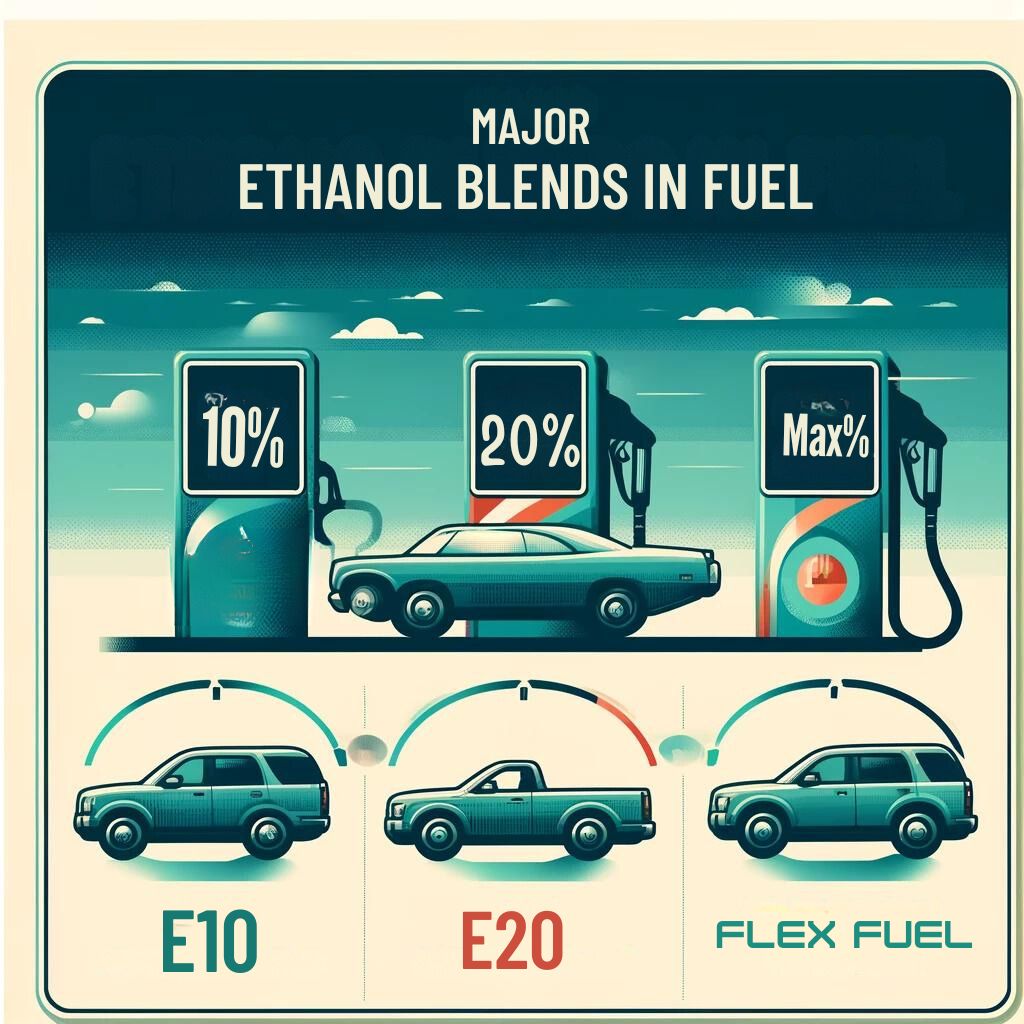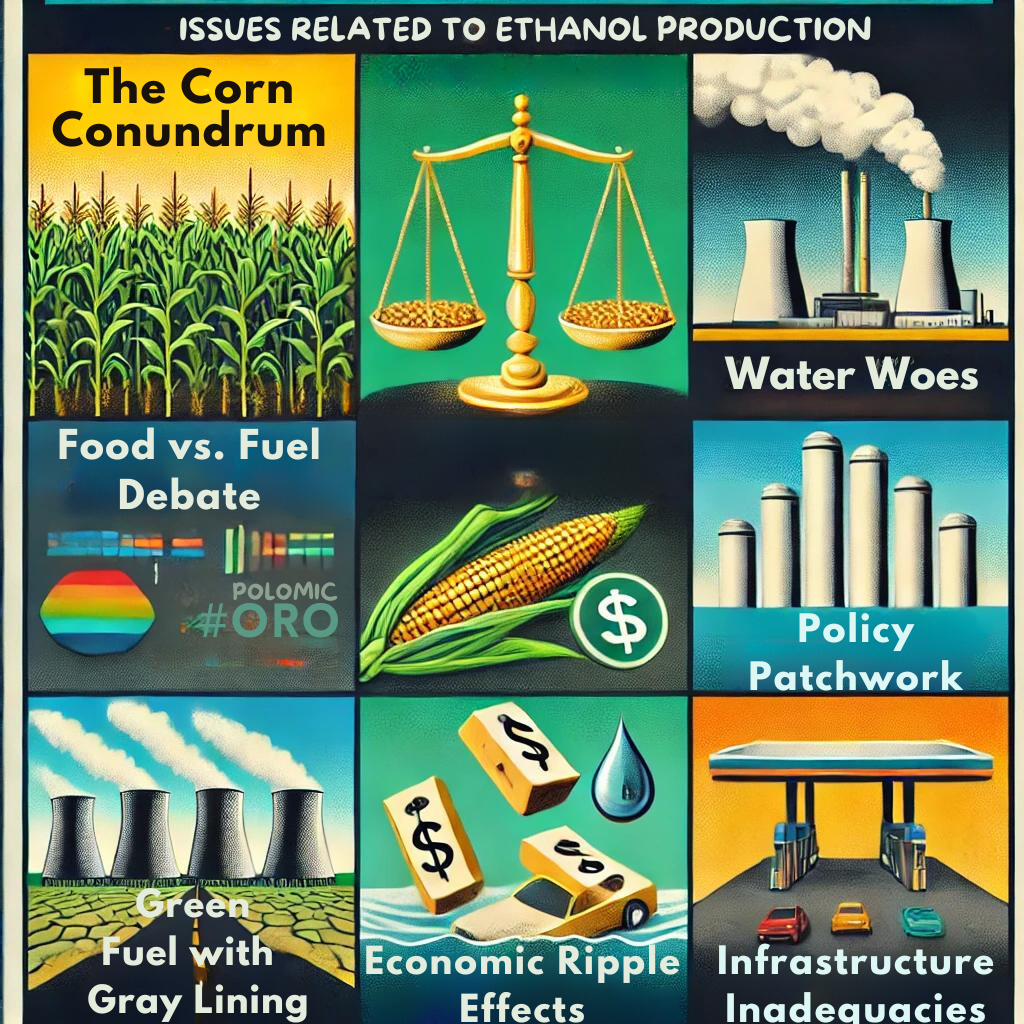The ambitious drive of India for ethanol-blending its gasoline has brought a sweeping change in its agricultural landscape and changed its fortunes in global trade. Once the top exporter of corn in Asia, the country now has turned into a net importer for the first time in decades due to the government policy to push for the production of ethanol made from corn. The policy U-turn to cut carbon emissions and leave sufficient sugar for domestic consumption has caused an acute shortage of corn, forcing the country to import a record 1 million tons in 2024, mainly from Myanmar and Ukraine.
| GS Paper | General Studies III |
| Topics for UPSC Prelims | Ethanol, Ethanol blending, India’s oil imports, Greenhouse gas emissions, GOBAR-DHAN scheme, Third-generation (3G) ethanol, and Flex-fuel vehicles. |
| Topics for UPSC Mains | Significance of Ethanol Production for India, Key Issues Related to Ethanol Production. |
Origin of the Article
This editorial is based on “Ethanol push turns India into corn importer, shaking up global market” published in The Economic Times on 04/09/2024. The article highlights India’s shift from a leading corn exporter to a net importer due to its push for corn-based ethanol production, causing domestic shortages, impacting various sectors, and reshaping global supply chains.
Relevancy for UPSC Students
Understanding India’s ethanol production policy is crucial for UPSC aspirants as it ties into multiple aspects of the syllabus, including economic development, environmental conservation, and agricultural policies. This knowledge helps comprehend the interconnections between domestic policies and global markets, a key area in the UPSC examination.
Why in News
India’s transition from a major corn exporter to a net importer, driven by its aggressive push for corn-based ethanol production, is an issue of critical importance for UPSC aspirants. This development not only impacts India’s agricultural policies and economic landscape but also has significant global trade implications. Understanding this shift is crucial for answering questions on topics such as renewable energy, environmental sustainability, and agricultural diversification.
What is Ethanol?
Ethanol is a colorless, flammable liquid. Its chemical formula is C₂H₅OH. It is a primary alcohol, and its typical alcoholic smell is so well known, it is prototypical. It is obtained naturally during fermentation of sugars by yeasts, while it is also synthesized industrially. This versatile compound has highly extensive uses in beverages, as a solvent, and as an additive in fuels.
Production of Ethanol
- Fermentation: This is the initial stage where yeast converts sugars from grains or fruits into ethanol and carbon dioxide. The process is simple yet effective, making it a primary method of production.
- Distillation: After fermentation, the mixture is heated to separate and concentrate the ethanol vapor, which is then condensed to achieve higher ethanol content.
- Dehydration: To obtain anhydrous ethanol, a dehydration process is employed, reducing the water content to less than 1%.
Major Ethanol Blends
- E10: This blend contains 10% ethanol and 90% gasoline, commonly used to reduce emissions and improve engine performance.
- E20: Featuring 20% ethanol and 80% gasoline, this blend offers greater environmental benefits while maintaining compatibility with most engines.
- Flex Fuel Vehicles: These vehicles are engineered to run on various ethanol-gasoline blends, including E85, providing flexibility and promoting ethanol use.

What is the Significance of Ethanol Production for India?
Energy Security and Import Reduction
Ethanol production is an important factor in enhancing energy security for the country by reducing its dependence on oil imports. The Government targets blending 20% ethanol by 2025-26, which would save as much as USD 4 billion annually. This approach not only reduces the import bill but also stabilizes the economy against global fluctuations in the price of oil.
Agricultural Diversification and Rural Economy Boost
Ethanol production offers significant benefits to India’s agricultural sector by providing alternative income sources. The shift to corn-based ethanol has diversified crop use, stabilizing agricultural commodity prices and boosting rural incomes. In 2024, 3.5 million tons of corn were used to produce 1.35 billion liters of ethanol, reflecting a substantial rise from previous years.
Environmental Impact and Climate Change Mitigation
Ethanol blending helps mitigate climate change by reducing greenhouse gas emissions. Studies on E20 blending have shown significant reductions in carbon monoxide emissions in both two-wheelers and four-wheelers. This environmental benefit aligns with India’s commitment to sustainable development.
Technological Innovation and Industrial Growth
The ethanol push is driving technological innovation in India’s biofuel sector. Investments in second-generation ethanol production from agricultural residues are rising, with the Indian Oil Corporation leading the charge by setting up a 2G ethanol plant in Panipat. This initiative fosters industrial growth and positions India as a leader in sustainable fuel technologies.
Geopolitical Leverage and Global Positioning
By reducing oil imports, India enhances its geopolitical stance and decreases its vulnerability to global oil politics. As one of the world’s largest ethanol producers, India is emerging as a significant player in the global biofuel market, bolstering its trade position and aligning with sustainable development goals.
Waste Management and Circular Economy
Ethanol production supports waste management by utilizing agricultural residues and food waste. Initiatives like the GOBAR-DHAN scheme exemplify this approach by converting biodegradable waste into biogas and ethanol, addressing critical issues like stubble burning, and promoting a circular economy.

What are the Key Issues Related to Ethanol Production?
The Corn Conundrum
India’s shift to corn-based ethanol has disrupted its corn trade dynamics, turning it from a top exporter to an importer. This shift has caused domestic corn prices to soar, affecting the poultry and starch industries, and altering trade relationships with countries like Vietnam and Bangladesh.
Food vs. Fuel Debate
The competition between food and fuel uses of crops like corn and sugarcane has reignited the food vs. fuel debate. The increased demand for ethanol distilleries has driven up food prices and raised concerns about food security, highlighting the need for a balanced approach to crop utilization.
Water Woes
Ethanol production from water-intensive crops like sugarcane exacerbates India’s water crisis. Sugarcane cultivation consumes a disproportionate amount of irrigation water, stressing resources in drought-prone regions. This calls for more sustainable water management practices in ethanol production.
Green Fuel with a Gray Lining
While ethanol is promoted as a clean fuel, its production involves significant environmental costs. The intensive use of fertilizers and pesticides leads to soil degradation and water pollution. Moreover, the energy-intensive conversion process can offset some of the environmental benefits of ethanol.
Economic Ripple Effects
The ethanol push has caused disruptions across various industries, particularly in the poultry and starch sectors. Rising corn prices have led to supply shortages and job losses, highlighting the broader economic impacts of the ethanol policy and the need for careful economic management.
Policy Patchwork
The rapid expansion of ethanol production has led to inconsistent and conflicting policies. Issues like the ban on genetically modified corn and sudden changes in sugarcane fuel use policies create regulatory uncertainty, deterring long-term investments and sustainable growth in the sector.
Infrastructure Inadequacies
India’s ambitious ethanol blending targets are hampered by inadequate infrastructure. The lack of sufficient blending facilities, storage capacities, and transportation networks poses significant challenges to achieving the 20% blending target by 2025-26, necessitating substantial infrastructure development.

Steps Taken to Ensure Ethanol Production is More Sustainable and Economically Viable
Diversifying Feedstock
Promoting alternative feedstocks like second-generation (2G) and third-generation (3G) ethanol can reduce reliance on food crops. Setting production targets and providing incentives for private sector investment in these technologies can enhance sustainability.
Maximizing Yield, Minimizing Impact
Implementing precision agriculture techniques can optimize resource use and improve yields. Utilizing IoT sensors, drones, and AI-driven analytics can reduce the environmental footprint of ethanol production while increasing efficiency.
Water-Smart Policies
Introducing water management policies, such as mandating water recycling in distilleries and promoting drip irrigation, can mitigate the water impact of ethanol production. Successful schemes like Madhya Pradesh’s ‘Kapildhara’ could serve as models for other regions.
Flex-Fuel Vehicle Push
Encouraging the adoption of flex-fuel vehicles can ensure consistent ethanol demand. Mandating flex-fuel compatibility for new vehicles and drawing lessons from Brazil’s successful FFV program can stabilize ethanol prices and offer consumers fuel choice flexibility.
Zonal Ethanol Production
Implementing a zonal approach to ethanol production can optimize resource use. Identifying ideal eco-regions for specific feedstocks and promoting localized production can reduce transportation costs and enhance sustainability.
Integrated Biorefinery Complexes
Developing integrated biorefinery complexes that combine ethanol production with other value-added processes can enhance viability. These complexes can generate biogas, manufacture bioplastics, and capture CO2, as exemplified by the Godavari Biorefineries in Maharashtra.
Smart Blending Infrastructure
Investing in smart blending infrastructure, such as automated blending systems and blockchain-based tracking, can enhance efficiency and ensure higher blending targets are met effectively.
Crop Insurance for Ethanol Feedstocks
Introducing specialized crop insurance schemes for ethanol feedstocks can encourage farmers to adopt these crops. Weather-indexed insurance products tailored for ethanol feedstocks can mitigate risks and promote sustainable agricultural practices.
Circular Economy in Distilleries
Adopting a circular economy approach in distilleries can enhance sustainability. Mandating the use of distillery waste for biogas production, using the resulting slurry as organic fertilizer, and capturing CO2 for industrial use can create a more sustainable ethanol production model.
PESTEL Analysis
| Political: Indian policy supports ethanol production to reduce the country’s dependence on oil and enhance energy security. Policy formulation like GOBAR-DHAN and ethanol blending targets kept the wheels moving on this transition. Economic: Ethanol production is expected to save USD 4 billion in oil imports annually and boost rural incomes by opening up new markets for farmers. Yet, rising corn prices may affect the poultry and starch industries, and of course, there is always the food vs. fuel debate. Social: The main food security issue in a country struggling with malnutrition due to the use of ethanol is that while farmers’ incomes are growing, shortages in corn will, in turn, increase the price of food items. Technological: India is also investing in advanced technologies for biofuels, such as the production of 2G ethanol. Technological innovations like precision agriculture and integrated biorefineries support sustainable practices. Environmental: Ethanol does help reduce carbon emissions, but soil degradation, water use, and pollution due to intensive farming show up as dark spots. Water management policy and diversification of feedstock use should go hand-in-hand to solve these issues. Legal: The future of ethanol in India will be determined based on different regulatory mechanisms for ethanol production, imports of GM corn, and use of water more sustainably. |
Conclusion
India’s ethanol revolution, while promising significant environmental and economic benefits, presents a complex challenge that demands strategic balance. As civil service aspirants, it is crucial to recognize the multifaceted impacts on agriculture, industry, and global trade. Thoughtful policy-making and innovative solutions are essential to ensure that India’s ethanol ambitions are sustainable, equitable, and aligned with broader developmental goals.
| UPSC Civil Services Examination, Previous Year Questions (PYQs) Mains Q. Discuss the importance of biofuels for India. Outline the challenges faced in the development of biofuel industry in the country. (GS Paper III, 2018) Q. Examine the role of third-generation (3G) ethanol and flex-fuel vehicles in achieving India’s sustainable energy goals. How can these technologies contribute to reducing greenhouse gas emissions and oil imports? Evaluate the potential challenges in their large-scale adoption within the Indian context. |


